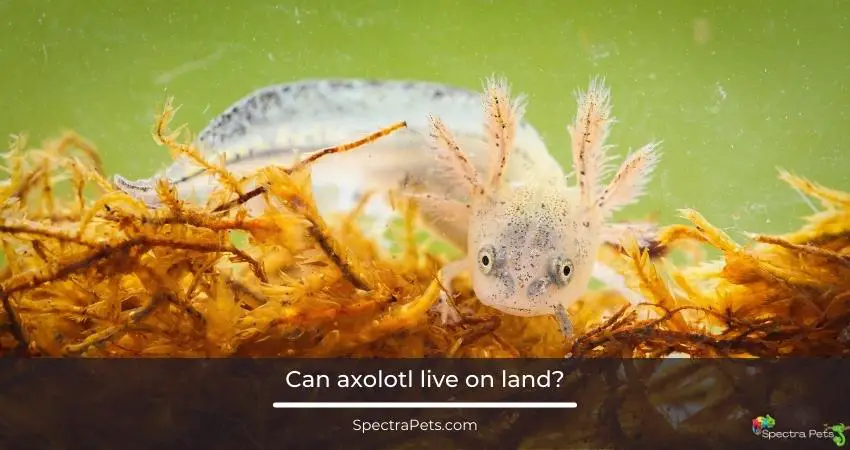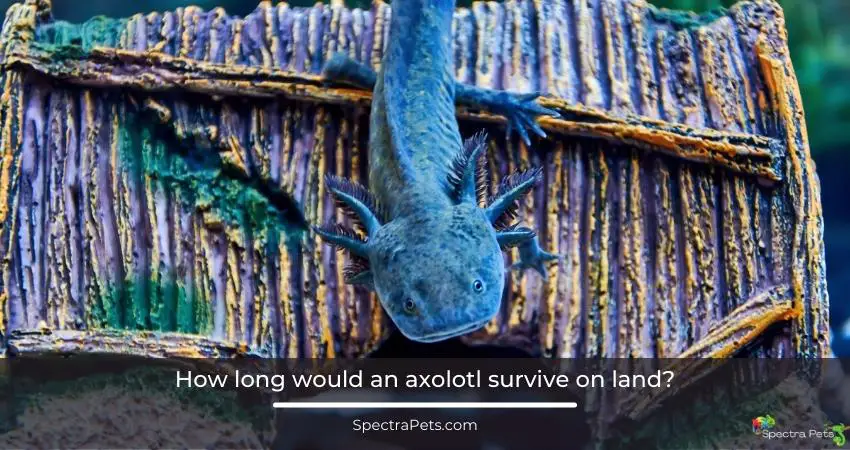Imagine you own an axolotl, a cute and colorful amphibian that looks like a cross between a salamander and a fish. You see it living happily in a tank filled with water and plants, enjoying swimming around and eating worms. You must have been content having such a cutesy aquatic creature.
But do you ever wonder what if you can get the best of worlds? Wouldn’t it be amazing if this axolotl could live on land too? Sadly that is not the case. An axolotl can’t live on land for more than an our, oxygen deprivation would kick in severely.
In this article, I will explain why this is the case. I assure you when you’re done reading you’ll be fascinated with these creature…

Why can’t axolotl live on land?
Generally, salamanders go through a process where the journey starts from the egg, then they enter the tadpole stage. And finally, develop fully functional developed lungs that allow them to live on land without any breathing issues.
However, Axolotl directly goes from the egg or larval stage to the adult stage. So the development process of the lung is missing, which ultimately prevents them from surviving on the land for a long time.
Axolotls normally breathe through their reddish-purple gills. During breathing the gills move and they take oxygen from the water. But on dry land, they can’t do this, so they fall short of oxygen, and die.
Read More: Axolotl’s lifespan in captivity
How long would an axolotl survive on land?
With the right temperature and ample amount of humidity, an axolotl may survive up to one hour.
Due to their extremely sensitive nature, they will become stressed and eventually die, so it’s never recommended to keep them out of water.

Only in case of changing the axolotl water tank, you can take them out of the water for a few seconds to keep them healthy. Make sure to keep water with the right parameter in another tank. Simply put them into that tank while changing the water of the main tank.
What will happen when an axolotl is out of water?
Axolotl is a slimy creature that needs to be in an aquatic environment to be happy and healthy. If they are exposed to a dry environment or land, axolotls will have multiple problems that can be deadly.
Let’s see what happens to them when you keep them out of water in the following part…
Damage to their vital limbs and organs
Due to the unusual life cycle of axolotls, they don’t have developed limbs and legs like other salamander species. So, they can’t support their body using their leg for walking on dry land. Inside the water tank, the axolotl can walk with the help of buoyancy which helps in the reduction of actual body weight.
But that does not happen in water, and they have to support their entire body weight with the limbs, which leads to excessive damage to the axolotl limbs. If you plan to keep your pet axie on a dry surface, it will lead to high stress on their body.
Eventually, a damaged leg and loss of mucus will lead to the departure of your pet. Apart from the external limb damage they will also have internal organ damage before their final breath.
Read More: Axolotl’s unique capacity of regrowing lost limbs
Dehydration leading to breathing problems
For healthy breathing, a slimy species like axolotl needs to be in an aquatic environment. As soon as they are not in the water zone, the slimy coat of the axolotl body will begin to dry. Due to dehydration and dry skin, your axie won’t be able to breathe using their skin.
Also, this dry skin will not be effective against any kind of bacteria and parasites. Which leads to a high probability of getting any infection from the external environment.
A combination of these problems would be fatal for the little cutie creatures.
Stress
Unlike other salamander species, axolotls are highly sensitive to stress factors. Factors like water quality, the oxygen level in the water, lighting intensity, temperature, humidity, etc. have a huge impact on their body function. Even a slight change in any of these factors would be stressful for them.
Besides, these fragile creatures do not like and feel stress physically, if you hold them with bare hands. And all these stress-triggering things can lead to loss of appetite and in the worst case death.
Final words
Axolotls are pure aquatic animals, and their external colorful gills are tailored for underwater breathing.
To keep your cute axie safe & sound, never leave them on a dry surface. Hopefully, this short post adds more brightness to your idea about an axolotl. Now, you know the answer to why an axolotl can’t live on land.
